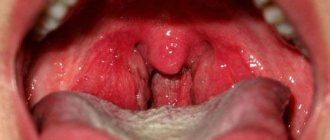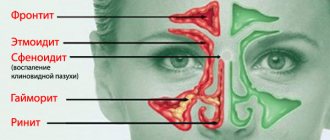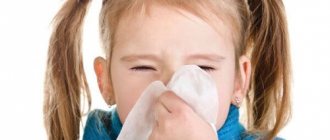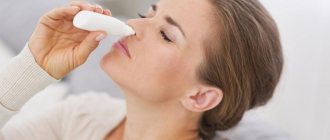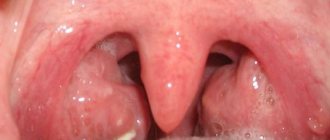Causes of rhinitis
They can be divided into two broad categories:
- Violation of local immunity . Here it is necessary to note some physiological features of the structure of the nasal cavity, which are actively involved in protecting against the penetration of dust and other small particles that carry bacteria and viruses.
- The integumentary epithelium of the nasal mucosa is covered with tiny cilia, which are constantly in motion and have the effect of pushing foreign particles out of the nasal cavity.
- Protective proteins called class A immunoglobulins are constantly present in the mucous membrane, which actively fight against penetrating infection. If the activity of local protective forces decreases, microorganisms that were in a dormant state and did not cause harm until then may immediately become active.
- External damaging factors. These factors reduce the effectiveness of the protective mechanisms of the nasal mucosa, resulting in an inflammatory reaction that leads to disease of the nasal mucosa. These factors include:
- The influence of local and general cooling on the human body. As a result, the body's resistance to protection against microbes is reduced.
- An important role is played by nasal injuries, various foreign objects in the nasal cavity (more often in young children), which irritate the mucous membrane with their presence for a long time. Surgical interventions are also considered to be a traumatic factor that increases the risk of an inflammatory reaction.
- Industrial hazardous factors. Being in a room filled with dust, harmful toxic and other chemical waste for a long time will cause irritation of the mucous membrane with increased sensitivity to various pathological agents.
- Allergic factor. House dust, fur, pollen, poplar fluff and many other tiny particles that surround us can cause allergic rhinitis.
Mistakes when self-treating a runny nose
- Failure to follow the instructions for use of vasoconstrictor drops.
Many people think that if they are used more often than necessary, the runny nose will go away faster. But that's not true. The body will simply get used to it, and the medicine will have no effect; - Using the same product for a long time is also a mistake
. If the drops do not improve the condition within 7 days, you need to consult a doctor and replace them with others; - Taking antibiotics without a doctor's prescription is something you shouldn't do
. After all, the nature of a runny nose can be not only bacterial, but also, for example, allergic; - When self-medicating, you should not use folk remedies
. For example, some people use onion juice as nasal drops. Due to its high vitamin C content, it can damage the nasal mucosa; - Another mistake is exposing the nose to heat.
Hot compresses or steam inhalation are helpful as long as they are not applied directly to the nose. Otherwise, you can get a burn to the nasal mucosa;
Symptoms of acute rhinitis
In its development, acute rhinitis goes through several successive stages. Each stage has its own characteristics that allow us to determine at what stage the disease is developing.
The first stage is characterized by the fact that microbes have just penetrated the nasal cavity and have an irritating effect on the mucous membrane. In this case, the following characteristic symptoms appear:
- Feeling of dryness in the nose
- Feeling of tickling, burning in the nasal cavity
Common symptoms include:
- Headache, which may gradually get worse.
- In some cases, there is a slight increase in body temperature up to 37.5 degrees.
The duration of the first stage lasts only a few hours, and sometimes even one or two days, after which the symptoms change and the disease moves to the next stage of its development.
The second stage begins from the moment when a lot of mucus of a liquid consistency begins to flow from the nose. During this stage, the symptoms of the disease increase. It is characteristic that the symptoms of dryness and burning in the nasal cavity disappear. But nasal congestion appears, and breathing becomes difficult. Patients may notice decreased sensitivity to odors.
Due to the fact that the nasal cavity communicates through small passages with the superficial mucous membrane of the eye - the conjunctiva, inflammation can spread to it. In this case, they speak of concomitant conjunctivitis (inflammation of the conjunctiva). There is lacrimation.
The third stage is inextricably linked with the reaction of the immune system to harmful microorganisms that have entered the nose. Usually this stage begins 4-5 days from the onset of the disease. It cannot be confused with anything, since during this period mucopurulent contents, of a thick consistency, and often with an unpleasant odor, begin to be released from the nose. The pus may also be yellowish-green in color.
Purulent contents with a fetid odor appear due to the fact that protective cells (phagocytes, neutrophils) penetrate into the nasal mucosa, which simultaneously cause an inflammatory process, with swelling of the surrounding tissues, and also “devour and digest” bacteria that have penetrated inside the nose. If the volume of captured pathogenic bacteria is too large, the phagocytes become too overcrowded and rupture, and at the same time processed killed bacteria come out - that is, pus.
After a few days, all of the above symptoms gradually subside, and the inflammatory process is nearing completion. The respiratory function of the nose and the general condition of the patient improve. The duration of inflammatory phenomena varies depending on the body’s resistance to resist the influence of internal and external harmful factors.
It happens that in a physically healthy person who leads an active lifestyle, carries out physical and hardening procedures, rhinitis occurs in a mild form and lasts only 2-3 days. Or, conversely, when the body’s defenses decrease, the disease is much more severe, with pronounced symptoms of intoxication (headache, muscle pain, a sharp increase in body temperature to high numbers of 38-39 degrees), and lasts not 2-3 days, but much longer, reaching sometimes up to 3-4 weeks, and even transition to a chronic form of the disease.
The indicated symptoms and stages of the inflammatory process in acute rhinitis are classic and in most cases of rhinitis of a specific origin are the same.
Otitis
The nasal cavity and the middle ear cavity communicate via the Eustachian (auditory) tube. Therefore, with a prolonged runny nose, inflammation can spread and cause otitis media.
Its most striking symptoms are:
- Throbbing pain that intensifies when swallowing or sneezing;
- The appearance of tinnitus with further deterioration in the perception of sounds;
- Headache, dizziness, increased body temperature;
- Serous or purulent discharge from the ears;
- Deterioration of sense of smell.
In addition to a runny nose, inflammation of the middle ear can be caused by other factors. For example, tonsillitis, poor diet, lack of vitamins, reduced immunity.
Treatment of otitis media involves the use of antibiotics prescribed by a doctor, drops for the ears, and vasoconstrictors for the nose.
(they relieve swelling of the Eustachian tube). Physiotherapy methods are also effective. For example, electrophoresis, blowing of the auditory tubes.
The main methods of preventing otitis are as follows:
- Proper and balanced nutrition;
- Hardening to strengthen the immune system;
- Treatment of infectious inflammation in the nasopharynx;
- Maintain proper sneezing and nose blowing technique.
Treatment of acute rhinitis
Acute uncomplicated rhinitis can be treated at home. Treatment is carried out depending on the stage of development of the inflammatory process.
In the treatment of acute rhinitis, both symptomatic drugs and special drugs aimed at reducing inflammatory processes in the nasal cavity are used. For bacterial infections, the use of antiseptic agents is justified, with the help of which the mucous membrane of the nasal cavity is washed and cleansed.
Treatment of the first stage of rhinitis is based on the use of:
- Hot foot baths for 10-15 minutes
- Applying mustard plasters to the sole area or calf muscles
- Drinking hot tea with raspberries or a slice of lemon
Medications used at this stage include:
- Antiseptic agents, local action. It is recommended to instill a 3-5% solution of protargol into the nose 2 times a day.
- Antiallergic drugs - diazolin, tavegil or loratadine tablets in tablet form. These drugs are taken mainly for allergic rhinitis. The dose is determined depending on the severity of sneezing, lacrimation and nasal discharge.
- Means that increase local immunity - drops with a solution of interferon, or lysozyme.
- For headaches, analgesic drugs are used - analgin, solpadeine, Tylenol. Children are recommended to take 250 mg. Adults – 500 mg. When a headache occurs.
Treatment of the second and third stages of acute rhinitis differs little from that for the initial manifestations of the disease. At the height of the disease, inflammatory processes in the nose intensify, purulent discharge appears, due to the increased activity of pathogenic bacteria and the immune system’s fight against them. In this regard, in especially severe cases of the disease, broad-spectrum antibiotics and various antimicrobial drugs are prescribed in combination with symptomatic treatment. These medications are taken orally in the form of tablets, capsules, or by rinsing the nasal cavity.
- Antibiotics used to treat acute rhinitis include:
- Amoxicillin is a broad-spectrum antibiotic, available in 500 mg tablets. Children over 12 years of age are prescribed 500 mg. 3 times a day, for 5-7 days.
- Bioparox is a local antibacterial drug. Available in aerosol form in bottles. Prescribed 1 inhalation inside each nostril every four hours.
To reduce the symptoms of nasal congestion, topical drugs are instilled into the nose, narrowing the blood vessels and thereby relieving spasm and swelling of the mucous membrane. As a result, nasal breathing improves and the patient feels much lighter. Such drugs include:
- Naphthyzin is a vasoconstrictor. For children, a 0.05% solution is used; for adults, a few drops of a 0.1% solution are instilled every 4-6 hours.
- Xylometazoline is also a vasoconstrictor drug. Children are prescribed nasal drops in the form of a 0.05% solution 2 times a day. For adults, the frequency of instillation is the same, the only thing is that the concentration of the drug is increased to 0.1%.
It should be taken into account that the use of nasal drops should not exceed more than 7-10 days. Since various side effects associated with disruption of the olfactory and cleansing functions of the nose may occur when using them. If you feel a burning sensation, local irritation and dryness in the nose, it is recommended to stop taking these medications.
Sinupret is a combination drug of herbal origin.
It is recommended to use to improve the outflow of mucus or pus from the nasal cavity. It has properties such as increasing local immunity, enhancing the secretion of mucus by the villi of the mucous membrane and thereby promoting a speedy recovery.
Used in the form of drops or tablets. The recommended dose is 2 tablets 3 times a day, or 50 drops of solution also 3 times a day. For children, the dose is determined by the doctor depending on the age of the child.
Treatment of rhinitis in infants
There are some features in the treatment and care of infants suffering from acute rhinitis.
- First, nasal congestion interferes with the baby's normal breathing and breastfeeding. Therefore, it is necessary to periodically clear the nasal passages from mucus stuck there. This procedure is carried out using a suction canister, immediately before feeding.
- If the mucus dries out and crusts form in the nasal cavity, they are carefully removed with a cotton swab pre-moistened in a sterile solution of sunflower oil or petroleum jelly. The crusts gradually soften and are easily removed from the nose.
- If, after the above procedures, nasal breathing is not restored, then drops of a 0.05% solution of xylometazoline (galazolin) are instilled into the nose.
- In the period between feedings, an antimicrobial drug 2% protargol solution is instilled into the nose, which also has an astringent effect and reduces the secretion of viscous mucus from the nose.
Why does my throat hurt without fever?
Causes of sore throat
An otolaryngologist still treats a sore throat, but without fever. In some cases, consultation and subsequent appropriate treatment from other specialists (dentist, infectious disease specialist, neurologist, oncologist) will be required. An important point in diagnosis is the identification of other, less pronounced symptoms (runny nose, dry throat, cough).
Chronic tonsillitis
Chronic pharyngitis is characterized by:
Treatment of chronic tonsillitis is aimed at reducing inflammation and restoring the barrier function of the tonsils. In the absence of the effect of conservative drug therapy, as well as the development of complications (heart defects, rheumatism), removal of the tonsils is necessary.
Simanovsky-Plaut-Viensant's tonsillitis
This is a specific inflammatory process that develops as a result of exposure to the microbial association of fusobacteria and spirochetes. This type of tonsil damage is in most cases unilateral.
Simanovsky's angina is characterized by:
- the formation of a crater-like ulcer on one of the tonsils, quite deep, but not very painful;
- the pain slightly increases when swallowing;
- runny nose, cough, fever are absent, the general condition of a person against the background of a specific sore throat practically does not change.
Chronic rhinitis
Throughout the year, many people often fall ill with acute inflammatory diseases of the pharynx and upper respiratory tract: rhinitis, bronchitis, sore throat. If these processes are constantly repeated, or the inflammation worsens before it has time to end, then in this case they speak of the chronicity of an acute infection. According to the World Health Organization, every person on earth gets sick on average four to six times during the year.
The most common causes of chronic rhinitis are:
- Deviation of the nasal septum. These include congenital anomalies of the nasal septum, turbinates, and post-traumatic injuries.
- Polyps inside the nasal cavity that block the nasal passages and contribute to congestion.
- Growths of adenoids on the back surface of the upper part of the pharynx. Adenoids are lymphatic tissue that prevents infection from entering the body. With frequent inflammatory processes, it grows and contributes to the chronicity of the process in the nasal cavity and sinuses.
- General chronic processes in the body. These include chronic diseases of the gastrointestinal tract, cardiovascular diseases, and a decrease in the overall resistance of the body.
There are several clinical forms of chronic rhinitis:
- Chronic catarrhal rhinitis
It is one of the complications of acute rhinitis, since frequent colds and runny nose lead to the constant presence of various pathogenic bacteria in the nose. A characteristic feature is constant uniform redness of the mucous membrane, constant discharge of mucopurulent contents. Lying on the side, the patient feels nasal congestion on the side that is below. In the cold, nasal congestion worsens.
Treatment consists of removing the causative factors leading to the chronic course of the disease.
- Chronic hypertrophic rhinitis
In some cases, chronic inflammation in the nasal cavity causes the lining of the cartilage and bone to grow in the nose. This process occurs slowly and imperceptibly, but can progress steadily. Anatomical formations in the nasal cavity, increasing in size, close the respiratory openings, and the patient constantly walks with a stuffy nose and develops a characteristic nasal voice. As the nasal turbinates grow, pockets are formed where infection and purulent contents are constantly present.
The diagnosis is made on the basis of endoscopic examination of the nasal cavity. Chronic hypertrophic rhinitis often leads to complications in the form of inflammation of the sinuses - sinusitis (sinusitis, frontal sinusitis).
Treatment involves surgical interventions. The operations are performed under local anesthesia and involve removing growths, which improves nasal breathing.
- Atrophic rhinitis
Atrophic rhinitis is a disease that is characterized by a widespread disruption of the normal anatomical structure of the nasal cavity, with the death of the villi of the mucous epithelium of the nasal cavity and disruption of their physiological functions.
Atrophic rhinitis is one of the most unfavorable consequences due to frequent inflammatory diseases of the nasal cavity and unfavorable environmental factors. It is also possible to develop dystrophic processes against the background of general severe diseases of organs and body systems.
Patients experience constant dryness in the nose. Purulent yellow-green discharge is observed, and when it dries, crusts form in the nasal cavity.
The treatment uses both general strengthening therapy in the form of taking multivitamin complexes, strengthening the immune system, hardening procedures, and locally using rinsing the nasal cavity with physiological sodium chloride solution, lubricating the mucous membrane with glycerin along with instillation of a 10% alcohol solution of iodine. An iodine solution improves the functioning of the villi of the mucous membrane.
Using sea salt inhalations is beneficial. To prepare the solution, take 5 grams of sea salt (one teaspoon) per glass of boiling water. Inhalations are carried out 2-3 times a day.
Stuffed ears after a runny nose
The ears, throat and nose are closely connected. Therefore, it is logical that when the disease of one organ passes, the disease passes to another. If your ears are blocked after a runny nose, then the reason for this may be an ongoing disease of the nasal passages. Ear congestion will go away if you thoroughly rinse the nasal passage. A saline solution prepared independently at the rate of 10 grams of sea salt per 100 milligrams of water is suitable for this, or you can buy a ready-made one at the pharmacy. After thorough rinsing, you should drip vasoconstrictor drops into your nose and repeat the same operation with your ears. Just don’t get carried away with such a procedure. It is also not recommended to use boric alcohol to warm the ears. If your ears are blocked after a runny nose, it will increase the pain and will not bring any real benefit. It is best to visit an ENT specialist, as he will thoroughly understand the problem and prescribe the correct, and most importantly, effective treatment.
- Stuffy ears when you have a runny nose
Prevention of rhinitis
Prevention of inflammation of the nasal mucosa includes a whole range of measures aimed at eliminating the influence of harmful factors, hypothermia, and timely treatment of other acute infectious and inflammatory diseases.
Preventive measures include:
- Preventing the occurrence of colds.
- It is not recommended to suddenly move from a warm room to a cold one, not to be in drafts, and not to drink ice water or other soft drinks.
- It is recommended to carry out hardening procedures. Pouring with cold water (start gradually, from using warm water to cool). Regular exercise.
- Nutrition should be nutritious, high-calorie, and most importantly, follow the correct regimen. The diet should consist of the consumption of fruits and vegetables with a high content of vitamin C (onions, cabbage, citrus fruits, currants). It is recommended to drink tea with raspberries, rosehip infusion, milk with honey.
- Periodic wet cleaning and ventilation of the room will prevent the entry and spread of infection.
- Timely consultation with a doctor at the first signs of the disease will prevent the occurrence of possible complications, especially in infants.
- Taking morning or evening sunbathing will strengthen the immune system, help in the formation of vitamin D and give a healthy glow to the child’s skin.
- Hygiene measures, such as washing your hands with soap after using the toilet and before eating, will help prevent infection from getting into the mouth or nose (by picking it with your finger), as often happens in young children.
Sinusitis
This disease is often confused with sinusitis. Sinusitis is an inflammation of the mucous membrane of the maxillary sinuses. And sinusitis is an inflammation of the mucous membranes of the maxillary, frontal (frontitis), ethmoid (ethmoiditis) and sphenoid (sphenoiditis) sinuses.
Sinusitis is manifested by the following symptoms:
- Nasal congestion and serous-purulent discharge. Sometimes they are mixed with blood due to damage to the capillaries;
- Pain in the forehead, eyes;
- Swelling of the face;
- Fever;
- Decreased sense of smell and appetite;
- Dry cough.
Sinusitis can be viral, bacterial or fungal in nature.
Once on the mucous membrane of the nasal sinuses, they linger on it and penetrate into the epithelial cells. That's when inflammation begins. In addition, sinusitis can be caused by allergies, caries, and stress.
Treatment of sinusitis involves the use of antibiotics (for the purulent type), antihistamines (for the allergic type) and antipyretics (for high temperatures). If the medications do not help, a puncture is performed and the sinuses are washed with special antiseptics.
For prevention purposes, it is necessary to get vaccinated, strengthen the immune system, exercise, and eat more vegetables and fruits. See a doctor in a timely manner so that sinusitis does not become chronic.
How to get rid of a runny nose using inhalations
Inhalations are a very effective way to get rid of a runny nose, because... active medicinal substances immediately reach the inflamed nasal mucosa. For this procedure, it is best to use a thick paper funnel. The wide end of the funnel is placed on the edge of the dish with the inhalation solution, and steam is inhaled through the narrow end. How are inhalations done?
- The easiest way is to add a little soda and a few drops of essential oil of fir, eucalyptus, and pine to a bowl of boiling water. Soda softens the nasal mucosa and facilitates the passage of mucus, and essential substances kill germs.
- Instead of essential oils, you can use alcohol tinctures of eucalyptus, propolis, mint, and calendula.
- It is also good to use infusions of medicinal herbs (which herbs to use - see Infusions and decoctions). Only for inhalation you need to make a more concentrated infusion than for oral administration. After the procedure, you can dilute the infusion you breathed over to the strength of tea and drink it.
When inhaling, you need to breathe mainly through your nose. The procedure time is 10-20 minutes. After this, it is not advisable to go outside for a while.
Inhaling the essential volatile substances of onion and garlic has a good healing and preventive effect. To do this, you need to grate or finely chop the garlic (or onion) and breathe over it as often as possible.
Nose drops
Burial technology.
Experts recommend proper instillation. You should blow your nose before the procedure. Then tilt your head to the left, tilting it back a little, or lie on your left side, drip the drug into your left nostril and stay in this position for 1-3 minutes. Then tilt your head to the right and perform the same actions with the right nostril. With this method, the medicine is distributed along the side wall of the nose and enters the nasal sinuses. 5 minutes after the procedure, you can blow your nose again.
- You can instill cedar, fir, sea buckthorn or menthol oil into your nose.
- Also used for instillation are the juice of beets, carrots, Kalanchoe, aloe, plantain and onion or garlic juice diluted with water (1 drop of juice per 1 tablespoon of water).
- It is good to instill a honey solution (1 part honey to 2 parts water), honey has antibacterial and anti-inflammatory properties. In general, honey can be added to any solution.
- You can use infusions and decoctions of medicinal plants (which herbs to use - see the chapter Infusions and decoctions).
Instillations are made several times a day, 3-5 drops in each nostril. The main principle when putting it into the nose is to first drop one drop; If there are no unpleasant sensations, then you can continue the procedure.
Instead of instillation, you can use tampons soaked in a medicinal solution. In this case, the contact of beneficial substances with the mucous membrane is longer. However, the medicine does not enter the paranasal sinuses. Therefore, the use of turundas is more suitable for those who have a slight runny nose and there is no mucus in the sinuses.
To get rid of a runny nose, you can also simply lubricate your nasal passages with all of the above remedies: juice, honey, oil. You just need to lubricate it more often - preferably every half hour. Homemade ointment is perfect for lubrication.
Lemon ointment . Pass 2 lemons with peel through a meat grinder, add 1 tbsp vegetable oil and 1 tbsp honey. Lemon and honey kill harmful microorganisms, and the oil softens the mucous membrane and relieves irritation. Store the mixture in the refrigerator.
